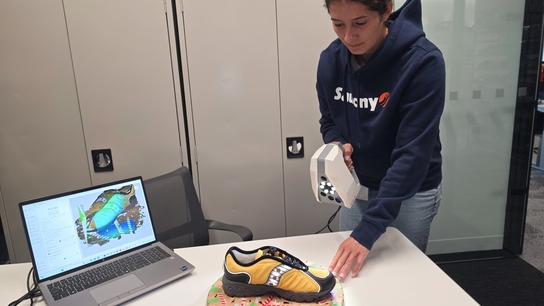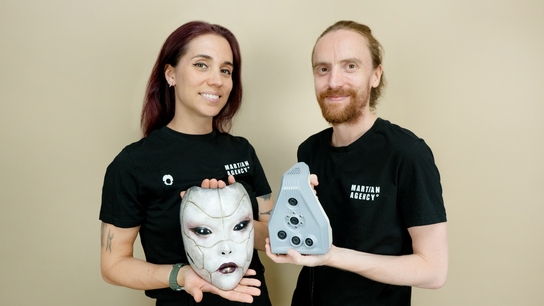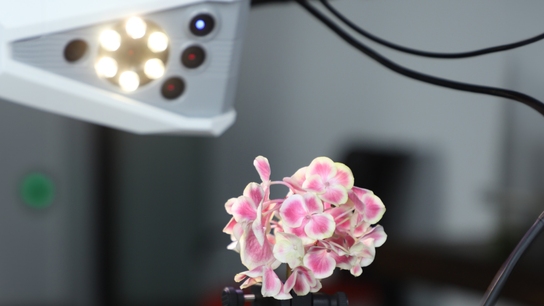3D Scanning with Artec Eva for state-of-the-art marine animal tracking
Summary: Swansea University uses Artec’s 3D scanning technology to create customized tags for marine animals to continuously monitor their behavior for marine biology research.
The Goal: Use the Artec Eva handheld 3D scanner for capturing marine animals such as sharks, dolphins, and turtles to get accurate measurement data needed for development and 3D printing of customized tags.
Tools Used: Artec Eva, Artec Studio 12
If you thought that 3D scanning and water don’t mix well together, think again! Artec’s professional 3D scanning solutions were used in an exciting marine biology project, led by Lloyd Hopkins, an ambitious Ph.D. student at the University of Swansea. Even though Artec 3D scanners aren’t waterproof just yet, they turned out to be an ideal solution for accurately capturing the inhabitants of the deep blue sea. By combining a portable Artec Eva 3D scanner with professional CAD software, Lloyd and his team found an innovative and efficient approach to creating customized tags for a variety of marine animals.
Swansea University’s Lab for Animal Movement (SLAM) researches marine animal life using state-of-the-art tagging technology and leading data visualization techniques. This is done to understand more about the lives of the amazing marine animals in the depths of the ocean, even when they are out of sight. Vital data gathered from these personalized tags, such as speed and activity levels of the animal, offers detailed information on migration patterns of the sea creatures as well as the effects that ocean temperatures have on their behavior. Working together with a range of other institutions and groups, including the King Abdullah University of Science and Technology, MIT, Australian Institute of Marine Science, Brown University, Valencia Oceanografic Fundacion, and Ecocean, a whale-shark research-conservation charity, Lloyd’s research is focused on developing innovative methods for attaching these tags to various marine animals in a non-invasive, easy-to-use way. If the tags are too loose – they will be ineffective and might even fall off. Too tight and you will cause distress to the animal.
Safe and easy to manage, it’s no wonder the use of animal-attached technology has become increasingly popular in recent years, not just for animal behavior research, but also for conservation and management efforts. “Ethical development of tagging practices and techniques is an important benchmark, but new technologies that allow us to fully quantify and simulate a tag’s effect on an animal are often under-utilized or unexplored,” says Lloyd.

To develop a novel, form-fitting attachment method for marine animals such as sharks, dolphins, and turtles, as well as simulate their effects, it was important to first obtain accurate measurements of each animal’s shape and structure.
Lloyd was after a solution that would quickly, and safely 3D scan the sea creatures. He also needed software that would give him and his team the freedom and tools to create customized tags. They chose Artec’s most popular 3D scanner, Artec Eva, and combined it with Artec Studio 12 scanning and post-processing software. Artec’s gold-certified reseller, Central Scanning Limited, provided the necessary training and consultancy, ensuring Lloyd and his team would make the most out of Artec’s professional 3D scannig solutions.

Scan of a blue shark fin
“We’re pretty confident here that use of 3D scanning techniques will be widely adopted as standard in the future for this type of research.” Lloyd Hopkins
Lloyd states that 3D scanning is the optimal way of capturing large animals and getting reliable data that can easily be examined and interacted with. Without the use of this important technology, much of the development phase would have to rely on sparse, estimated data that might not translate properly to a real-world application.
“Once we had decided on 3D scanning as a method, the Artec brand stood out quite quickly due to its usability, its functionality, and its fantastically powerful software that did most of the hard work for us.”- Lloyd Hopkins
For the project, Lloyd and his team used the lightweight Artec Eva 3D scanner to quickly and accurately capture 3D data from both deceased and living marine animals such as sharks, turtles and dolphins, as well as some fish and crab species.
Using an Eva ensured that they got the measurement data they needed by capturing animals both indoors and outdoors. Thanks to the portable Artec 3D battery pack, scanning could take place anywhere, even right next to the water! It only took a few days to get the needed information on different species, making the use of 3D scanning incredibly time-effective and remarkably easy considering that capturing wet, shiny and moving animals would be difficult for most 3D scanners!

3D scan of a large loggerhead turtle
The workflow of the project was as follows: First, Lloyd and his team obtained a high-quality scan of an animal. In the case of the sharks, turtles, and a dolphin, these were already deceased specimens kept in storage at the Valencia Oceanografic aquarium. One of the shark’s fins that Lloyd had to scan was bent, due to its storage in a compact freezer. This, however, wasn’t a problem, as he was able to capture a series of measurements of the fin and rebuild the model himself.
Some of the 3D scanned animals, however, were very much alive! When capturing the live dolphin, for example, trainers were able to encourage this highly intelligent animal to the side of the pool, where Lloyd made quick and detailed scans of its beautiful fins. It was enough to get one side captured and then have it stitched together in Artec Studio 12 scanning and post-processing software.
After 3D scanning the animals, creating the final 3D model of a tag involved the following steps:
The scan data was used to effectively build the design directly around the scanned animal using Autodesk Meshmixer and Fusion 360 CAD software. Using Autocad Fusion 360, Lloyd designed and built the tag around the scans, and rebuilt a fin from the gathered measurements. He then used Meshmixer to make changes to the mesh, e.g., smooth over scan stitching lines and correct difficult to scan areas such as the dolphin’s mouth.
With a designed tag shaped to fit the animal, it was ready for printing and real-world testing. The hard work paid off. The finished product was instantly better in terms of size compared to those created using measurements taken by hand.
Lloyd stated that the information gathered via 3D scanning is much more reliable and precise, compared to records obtained the traditional way, by hand; as this type of data capture is time-consuming, leaves room for error and can make it harder to understand how these measurements fit together in space relative to the animal. Though you can use casts to get the complete shape, it can only be done on smaller creatures or just part of an animal. Casting also takes a lot of time, as you need to wait for the cast to set, and this is not the best option for living animals, which can’t hold still for a long time!

3D scan of a dolphin
Lloyd and his team successfully obtained all of the precise data they needed in very little time. Though research for the project is still ongoing, 3D scans of the marine animals, particularly the dolphin 3D data, have already attracted attention of trainers and vets in Spain. Impressed with the possibilities of the 3D scanning technology animal experts say it would save them significant time in veterinary duties such as monitoring growth and performing animal autopsies, for which many measurements of the deceased animal are required.
Scanners behind the story
Try out the world's leading handheld 3D scanners.





